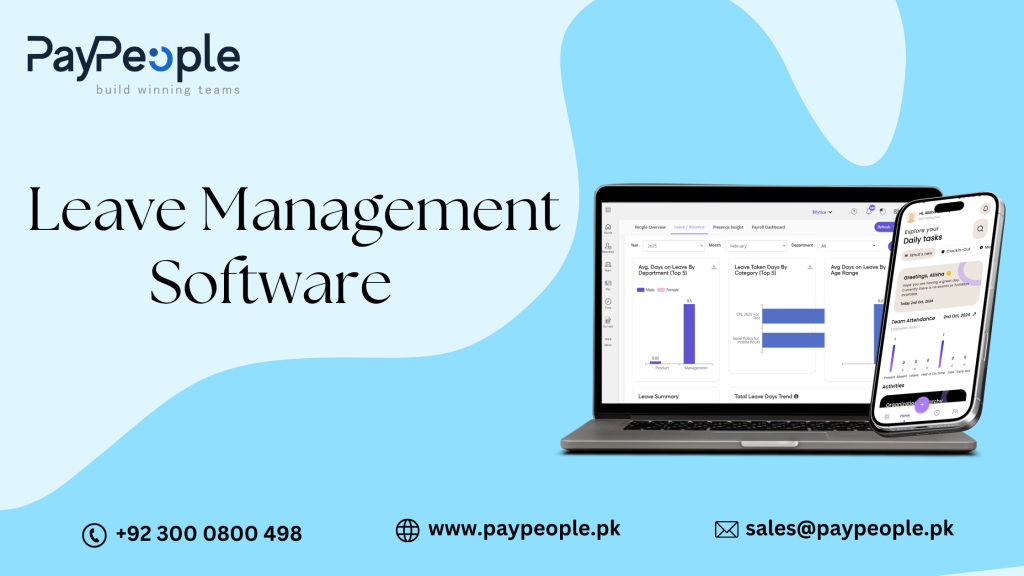Paypeople # 1 is one of the top HRIS Systems organizations that rely on insights derived from analytics and reporting to make informed decisions and drive strategic initiatives. Human Resource Information Systems play a pivotal role in providing comprehensive analytics and reporting capabilities to HR professionals, enabling them to gain actionable insights into various aspects of workforce management. This article explores the diverse analytics and reporting capabilities offered by HRIS, highlighting their significance in driving organizational effectiveness and performance.
Click to Start Whatsapp Chat with Sales
Call #:+923000507555
Email: sales@Paypeople.pk
Paypeople # 1 HRIS Systems

Real-Time Data Visualization
HRIS Systems offers real-time data visualization tools that transform complex HR data into interactive charts, graphs, and dashboards. These visualizations provide HR professionals with instant insights into key workforce metrics, such as headcount, turnover rates, and employee demographics. By presenting data in a visually appealing format, HRIS systems facilitate quick and intuitive analysis, enabling informed decision-making.
Customizable Reporting Templates
HRIS provides customizable reporting templates that allow HR professionals to generate tailored reports based on their specific requirements. These templates cover a wide range of HR metrics, including recruitment, performance management, compensation, and employee engagement. By offering flexibility in report customization, HRIS empowers HR teams to extract relevant insights and track progress toward organizational goals.
Ad Hoc Querying and Data Exploration
HRIS enables ad hoc querying and data exploration, allowing HR professionals to delve deeper into HR datasets and uncover hidden patterns or trends. These systems provide user-friendly interfaces and query builders that facilitate dynamic data exploration without the need for advanced technical skills. By empowering HR professionals to conduct on-the-fly analysis, HRIS fosters a culture of data-driven decision-making.
Predictive Analytics and Forecasting
Advanced HRIS Systems in Pakistan leverage predictive analytics and forecasting algorithms to anticipate future workforce trends and outcomes. These systems analyze historical HR data, such as performance ratings, turnover rates, and recruitment metrics, to forecast future workforce needs and identify potential risks or opportunities. By providing predictive insights, HRIS enables proactive workforce planning and talent management.

Benchmarking and Comparative Analysis
The Payroll Management System supports benchmarking and comparative analysis by comparing organizational HR metrics against industry standards or peer benchmarks. These systems enable HR professionals to assess their performance relative to competitors or industry norms, identify areas for improvement and set realistic goals. By benchmarking HR metrics, HRIS facilitates continuous improvement and best practices adoption.
Compliance Reporting and Audit Trails
HRIS assists organizations in compliance reporting and audit trails by generating comprehensive reports on regulatory compliance and HR policy adherence. These systems track changes to HR data, maintain audit trails of user activities, and generate compliance reports for regulatory audits or internal reviews. By ensuring compliance with legal requirements, HRIS mitigates the risk of penalties and lawsuits.
Workforce Planning and Scenario Modeling
HRIS supports workforce planning and scenario modeling by simulating different workforce scenarios and projecting their impact on business outcomes. These systems enable HR professionals to assess the potential consequences of workforce changes, such as restructuring, downsizing, or expansion, and develop strategies to mitigate risks or capitalize on opportunities. By providing scenario-based analysis, HRIS systems enhance strategic workforce planning.
Employee Engagement and Sentiment Analysis
Some employment law offer employee engagement and sentiment analysis capabilities that measure employees’ sentiment and satisfaction levels through surveys, feedback forms, or sentiment analysis algorithms. These systems capture qualitative feedback from employees and analyze it to identify trends, sentiment shifts, or areas of concern. By monitoring employee engagement, HRIS systems help organizations proactively address issues and enhance employee satisfaction.
Cost Analysis and Budget Tracking
HRIS systems provide cost analysis and budget tracking features that enable HR professionals to track HR-related expenses, such as payroll costs, benefits expenditures, and training expenses. These systems generate reports on HR costs, analyze spending patterns, and forecast future HR budgets. By monitoring costs and budget variances, HRIS systems support financial planning and resource allocation decisions.
Integration with External Data Sources
Finally, HRIS systems integrate with external data sources, such as market data, economic indicators, or workforce trends, to enrich HR analytics and reporting capabilities. These integrations enable HR professionals to contextualize HR data within broader business or industry trends, gaining deeper insights into workforce dynamics and market conditions. By leveraging external data sources, HRIS systems enhance the relevance and accuracy of HR analytics.
Conclusion
In conclusion, HRIS systems offer a wide range of analytics and reporting capabilities that empower HR professionals to extract actionable insights from HR data and drive strategic decision-making. From real-time data visualization and customizable reporting templates to predictive analytics and compliance reporting, HRIS systems provide comprehensive solutions for analyzing workforce trends, optimizing HR processes, and aligning HR strategies with organizational goals. By harnessing the power of HR analytics, organizations can gain a competitive advantage, improve workforce productivity, and foster a culture of data-driven decision-making in today’s dynamic business landscape.
Click to Start Whatsapp Chat with Sales
Call #:+923000507555
Email: sales@Paypeople.pk
HRIS Systems
HRIS Systems
HRIS Systems
We are one of the best What analytics and reporting capabilities do HRIS Systems offer? Price in Pakistan in Azad Kashmir, Bagh, Bhimber, khuiratta, Kotli, Mangla, Mirpur, Muzaffarabad, Plandri, Rawalakot, Punch, Balochistan, Amir Chah, Bazdar, Bela, Bellpat, Bagh, Burj, Chagai, Chah Sandan, Chakku, Chaman, Chhatr, updated on 2025-07-03T11:00:59+05:00 Dalbandin, Dera BugtiBarcode Shop offer lowest What analytics and reporting capabilities do HRIS Systems offer? Price Face Recognition in cities Dhana Sar, Diwana, Duki, Dushi, Duzab, Gajar, Gandava, Garhi Khairo, Garruck, Ghazluna, Girdan, Gulistan, Gwadar, Gwash, Hab Chauki, Hameedabad, Harnai, Hinglaj, Hoshab, Ispikan, Jhal, Jhal Jhao, Jhatpat, Jiwani, Kalandi, Kalat, Kamararod, Kanak, Kandi, Kanpur, Kapip, KapparWe can deliver Face Recognition in Karodi, Katuri, Kharan, Khuzdar, Kikki, updated on 2025-07-03T11:00:59+05:00 Kohan, Kohlu, Korak, Lahri, Lasbela, Liari, Loralai, Mach, Mand, Manguchar, Mashki Chah, Maslti, Mastung, Mekhtar, Merui, Mianez, Murgha Kibzai, Musa Khel Bazar, Nagha Kalat, Nal, Naseerabad, Nauroz Kalat, Nur Gamma, Nushki, Nuttal, Ormara, Palantuk, Panjgur, Pasni, Piharak, Pishin, Qamruddin Karez, Qila Abdullah, Qila Ladgasht and this was updated on 2025-07-03T11:00:59+05:00 We also deal with What analytics and reporting capabilities do HRIS Systems offer? Price in Qila Safed, Qila Saifullah, Quetta, Rakhni, Robat Thana, Rodkhan, Saindak, Sanjawi, Saruna, Shabaz Kalat, Shahpur, Sharam Jogizai, Shingar, Shorap, Sibi, Sonmiani, Spezand, Spintangi, Sui, Suntsar, Surab, Thalo, Tump, Turbat, Umarao, pirMahal, Uthal, Vitakri, Wadh, Washap, Wasjuk, Yakmach, Zhob, Federally Administered Northern Areas/FANAWe are already sent Face Recognition to these places – Astor, updated on 2025-07-03T11:00:59+05:00 Baramula, Hunza, Gilgit, Nagar, Skardu, Shangrila, Shandur, Federally Administered Tribal Areas/FATA, Bajaur, Hangu, Malakand, Miram Shah, Mohmand, Khyber, Kurram, North Waziristan, South Waziristan, Wana, NWFP, Abbottabad, Ayubia, Adezai, Banda Daud Shah, Bannu, Batagram, Birote, Buner, Chakdara, Charsadda, Chitral, Dargai, Darya Khan, Dera Ismail Khan and this was updated on 2025-07-03T11:00:59+05:00 we are planning to open a branch office of in Drasan, Drosh, Hangu, Haripur, Kalam, Karak, Khanaspur, Kohat, Kohistan, Lakki Marwat, Latamber, Lower Dir, Madyan, Malakand, Mansehra, Mardan, updated on 2025-07-03T11:00:59+05:00 Mastuj, Mongora, Nowshera, Paharpur, Peshawar, Saidu Sharif, Shangla, Sakesar, Swabi, Swat, Tangi, Tank, Thall, Tordher, Upper Dir, Punjab, Ahmedpur East, Ahmed Nager Chatha, Ali Pur, Arifwala, Attock, Basti Malook, BhagalchurFace Recognition in Bhalwal, Bahawalnagar, Bahawalpur, Bhaipheru, Bhakkar, Burewala, Chailianwala, Chakwal, Chichawatni, Chiniot, Chowk Azam, Chowk Sarwar Shaheed, Daska, Darya Khan, Dera Ghazi Khan, Derawar Fort, updated on 2025-07-03T11:00:59+05:00 Dhaular, Dina City, Dinga, Dipalpur, Faisalabad, Fateh Jang, Gadar, Ghakhar MandiFace Recognition What analytics and reporting capabilities do HRIS Systems offer? Price s Demands very high in Gujranwala, Gujrat, Gujar Khan, Hafizabad, Haroonabad, Hasilpur, Haveli Lakha, Jampur, Jhang, Jhelum, Kalabagh, Karor Lal Esan, Kasur, Kamalia, Kamokey, Khanewal, Khanpur, Kharian, Khushab, Kot Addu, Jahania, Jalla Araain, Jauharabad, Laar, Lahore, Lalamusa, Layyah, Lodhran, Mamoori, Mandi Bahauddin, Makhdoom Aali, Mandi Warburton, Mailsi, Mian Channu, Minawala, Mianwali, Multan, Murree, Muridke, Muzaffargarh, Narowal, Okara, Renala Khurd, Rajan Pur, Pak Pattan, Panjgur and this was updated on 2025-07-03T11:00:59+05:00 and current What analytics and reporting capabilities do HRIS Systems offer? Price of is Rs 100 in Pattoki, Pirmahal, Qila Didar Singh, Rabwah, Raiwind, Rajan Pur, Rahim Yar Khan, Rawalpindi, Rohri, Sadiqabad, Safdar Abad – (Dhaban Singh), Sahiwal, Sangla Hill, Samberial, Sarai Alamgir, Sargodha, Shakargarh, Shafqat Shaheed Chowk, Sheikhupura, Sialkot, Sohawa, Sooianwala, Sundar (city), Talagang, Tarbela, Takhtbai, Taxila, Toba Tek Singh, Vehari, Wah Cantonment, Wazirabad and this was updated on 2025-07-03T11:00:59+05:00 Software solutions are widely available with Price updated on 2025-07-03T11:00:59+05:00 in Sindh, Ali Bandar, Baden, Chachro, Dadu, Digri, Diplo, Dokri, Gadra, Ghanian, Ghauspur, Ghotki, Hala, Hyderabad, Islamkot, Jacobabad, Jamesabad, Jamshoro, Janghar, Jati (Mughalbhin), Jhudo, Jungshahi, Kandiaro, Lahore, Kashmor, Keti Bandar, Khairpur, updated on 2025-07-03T11:00:59+05:00 Khora, Klupro, Khokhropur, Korangi, Kotri, Kot Sarae, Larkana, Lund, Mathi, Matiari, Mehar, Mirpur Batoro, Mirpur Khas, Mirpur Sakro, updated on 2025-07-03T11:00:59+05:00 Mithi, MithaniThe Barcode Shop deliver high quality Face Recognition in updated on 2025-07-03T11:00:59+05:00 Moro, Nagar Parkar, Naushara, Naudero, Noushero Feroz, Nawabshah, Nazimabad, Naokot, Pendoo, Pokran, Qambar, Qazi Ahmad, Ranipur, Ratodero, Rohri, Saidu Sharif, Sakrand, Sanghar, Shadadkhot, Shahbandar, Shahdadpur, Shahpur Chakar, Shikarpur, Sujawal, Sukkur, Tando Adam, Tando Allahyar, Tando Bago, Tar Ahamd Rind, Thatta, Tujal, Umarkot, Veirwaro, Warah and this was updated on 2025-07-03T11:00:59+05:00
19-3-2024


